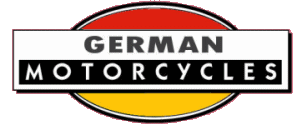

A Brief History of the Marque
Manufactured by Elsterwerdaer Fahrzeugwerke, C.W. Reichenbach, Elstwerda, 1926-1932
The firm built motorcycles of 75cc to 497 cc using engines from DKW, Küchen, Kühne, Sachs, Bark, JAP and Windhoff. The company also built motorcycle-based three-wheeled delivery vehicles, and mofas through to 1940.
1918 bis 1924
Nach anfänglichen, großen Schwierigkeiten gelingt es an die früheren Geschäftsverbindungen anzuknüpfen und die Fahrradproduktion läuft wieder an. Aber nicht nur der deutsche Markt wurde wieder aufnahmefähig, sondern neue Absatzmärkte erschlossen sich auch in Holland, Dänemark, den baltischen Staaten, in Afrika und Südamerika für "Aegir und das neue Rad "C.W.R.". Die Fabrik war durch umfangreiche Erweiterungsbauten beträchtlich gewachsen und an die 400 Arbeiter stellten 200 Fahrräder täglich her, als ein Großbrand im November 1924 die meisten Produktionsanlagen zerstört.
1925 bis 1928
Mit erstaunlicher Schnelligkeit gelang es die zerstörten Fabrikteile großräumiger, heller und zweckmäßiger wieder aufzubauen und schon 1925 wurde die alte Produktionskapazität wieder erreicht. Doch mittlerweile hat das Fahrrad Konkurrenz bekommen. Nach 1925 hatte ein Siegeszug wirklich zuverlässiger Motorräder begonnen und zwang das Werk, neben seinen bewährten "Aegir"-Rädern den Motorradbau in großem Umfang aufzunehmen. Im Juni 1928 lief die Produktion eigener Motorradkonstruktionen an und im Herbst erschienen die ersten "Elfa"-Maschinen auf den Strassen.
1929 bis 1939
Auch Fahrräder werden jetzt unter der Marke "Elfa" angeboten, "Aegir"-Räder werden noch parallel dazu bis 1931 hergestellt, danach nur noch Elfa«s. Die Elfa-Räder werden zum Teil mit einer Elster als Schutzblechfigur angeboten.
Die anfangs recht erfolgreiche Motorradproduktion (Ende 1929 liefen schon 2000 Motorräder auf den Strassen) wird Mitte der 30er Jahre eingestellt, Fahrräder mit Hilfsmotor (im Volksmund auch "Hühnerschreck" oder "Hackenwärmer" genannt) bleiben aber weiter im Programm. 1937 stirbt Carl-Wilhelm Reichenbach in Elsterwerda-Biehla. Sein Sohn Erich hatte zuvor schon die Geschicke der Firma übernommen und führt diese nun als "Elsterwerdaer Fahrradfabrik, E. W. Reichenbach GmbH" weiter. Bei Ausbruch des Krieges 1939 beschäftigt die Fabrik ca. 500 Arbeiter.
1939 bis 1945
Nach Kriegsausbruch erfolgte abermals die Umstellung auf die Produktion kriegswichtiger Güter (Gewehrschlösser, Sturmgewehre u.ä.). Am 19. April wird die Fabrik durch einen Bombenangriff, der vermutlich dem Bahnhof galt, fast vollständig zerstört. Dies bedeutete auch gleichzeitig das Ende der Fahrradproduktion in Elsterwerda.
Early Years
Bicycle production increased quite rapidly in the early 20th century, with their products being well received. Many were marketed under the brand "Aegir", and this was the name they gave to their first motorcycles, production of which began around 1908. The frame and forks for these were of their own manufacture, the remainder of the components including engine tank and wheels were purchased from other suppliers.
1918 to 1924
Following the Armistice the firm suffered considerable difficulties; however, the previous business connections were successfully re-established and bicycle production continued. The German market was proved viable and new markets opened up in Holland, Denmark, the Baltic States, Africa and South America for "Aegir and the new "CWR" bicycles. The factory had grown considerably due to extensive extensions, with 400 workers producing 200 bicycles a day - then a major fire in November 1924 destroyed most of the production facilities.
1925 to 1928
The destroyed parts of the factory were rebuilt with astonishing speed in a more spacious, brighter and more functional way and in 1925 the old production capacity was reached again. But meanwhile the bike has got competition. After 1925 a triumphant advance of really reliable motorcycles had begun and forced the factory to start manufacturing large-scale motorcycles in addition to its tried and tested "Aegir" wheels. In June 1928 the production of own motorcycle designs started and in autumn the first "Elfa" machines appeared on the streets.
1929 to 1939
Bicycles were now also offered under the "Elfa" brand, and "Aegir" bicycles were still produced in parallel until 1931, after which only Elfa. Some of the Elfa bicycles were offered with a magpie ornament for the front mudguard.
Motorcycles offered in the 1929 catalogue included "T and LS 200cc Windhoff Motor, Villiers, 300 ccm Kühne Motor, 500 (350) ccm K-Fourstroke Motor" and in 1930 there was a 200cc three-wheeler. From 1936 to 1939 there were 98cc Sachs models.
The initially quite successful motorcycle production (2000 had been built by the end of 1929) was discontinued in the mid-1930s, but bicycles with auxiliary engines (also known as "Hühnerschreck" or "Hackenwärmer") remained in the catalogue. In 1937 Carl-Wilhelm Reichenbach died in Elsterwerda-Biehla. His son Erich had already taken over the company and was now running it as "Elsterwerdaer Fahrradfabrik, EW Reichenbach GmbH". When the war broke out in 1939 the factory employed around 500 workers.
1939 to 1945
After the outbreak of war, there was another switch to the production of goods essential to the war effort (rifle locks, assault rifles, etc.). On April 19 the factory was almost completely destroyed in a bombing raid, which was probably aimed at the railway station. This brought an end to production in Elsterwerda.
Sources: GTU Oldtimerservice, Tragatsch p125, elfarad.de (archive), oldtimer-ek.de.